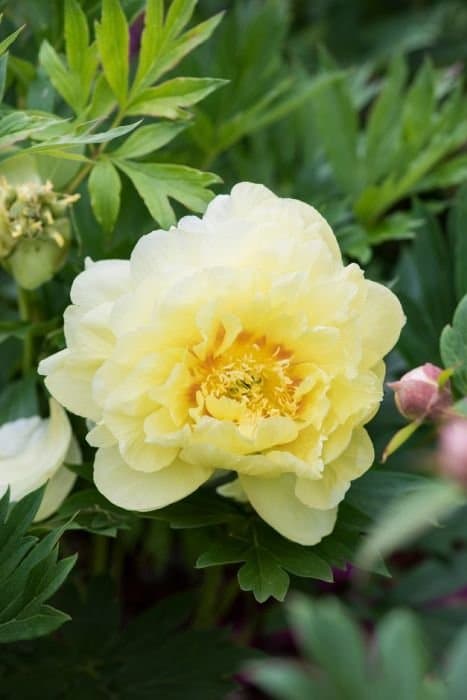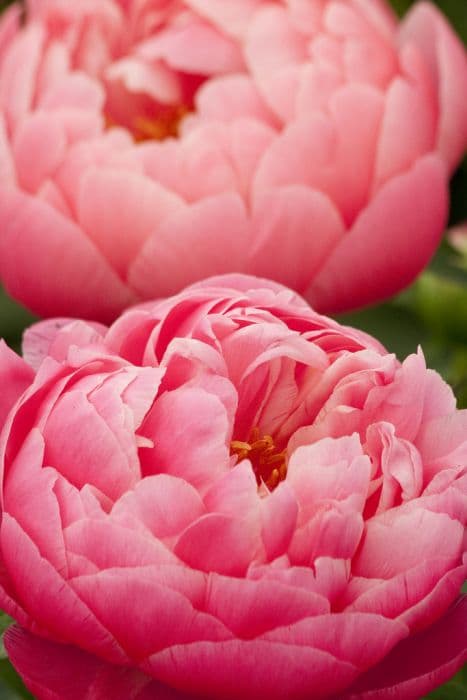Balearic Peony Paeonia cambessedesii

ABOUT
The plant known as the Balearic peony is an ornamental flowering plant renowned for its captivating beauty. It features lush, deep green leaves which present a leathery texture. The leaves are broadly divided, further emphasizing the plant’s full, rounded appearance. In spring, the Balearic peony boasts large, bowl-shaped blooms which are particularly noted for their vivid pink color that seems to vary slightly in intensity from petal to petal. The petals are delicate yet substantial, coming together to form a conspicuous flower that stands out against the dense green foliage. As the plant matures, the blossoms may develop a soft, almost silvery shimmer on their surface. The flowers emit a subtle, sweet scent, which only adds to the plant's charm, attracting pollinators and human admirers alike. After the flowering season, the plant produces seed capsules, adding further interest to its appearance. Throughout the growing season, the Balearic peony maintains a lush, robust form that is visually pleasing in garden settings.
About this plant
 Names
NamesFamily
Paeoniaceae
Synonyms
Balearic Peony, Majorcan Peony
Common names
Paeonia cambessedesii.
 Toxicity
ToxicityTo humans
The Paeonia cambessedesii, commonly known as the Balearic peony, is not regarded as a particularly toxic plant to humans. However, like many plants, it may cause mild stomach upset if ingested in large amounts due to the presence of compounds such as glycosides. The roots contain higher concentrations of these compounds and are more likely to cause symptoms if eaten. Possible symptoms of ingestion include nausea, vomiting, diarrhea, and abdominal pain. Handling the plant may also cause skin irritation in some individuals due to its content of peonol. It is generally advisable to avoid consuming any parts of ornamental plants as they are not intended for human consumption.
To pets
The Balearic peony is not typically listed as a highly toxic plant to pets. However, as with its effects on humans, if a pet were to ingest a large quantity of the Paeonia cambessedesii, particularly the roots, it could potentially experience gastrointestinal upset, including symptoms such as vomiting and diarrhea. While not severely toxic, it is best to prevent pets from consuming plant material to avoid any potential discomfort or more serious reactions in case of a sensitivity or allergy to the plant's compounds. If ingestion occurs and adverse symptoms are observed, contacting a veterinarian is recommended.
 Characteristics
CharacteristicsLife cycle
Perennials
Foliage type
Deciduous
Color of leaves
Green
Flower color
Pink
Height
1-2 feet (30-60 cm)
Spread
1-2 feet (30-60 cm)
Plant type
Shrub
Hardiness zones
6
Native area
Mediterranean
Benefits
 General Benefits
General Benefits- Aesthetic Appeal: Paeonia cambessedesii, commonly known as the Balearic peony, produces large, attractive flowers that are visually striking in gardens and landscapes.
- Seasonal Interest: This peony species blooms in spring, offering seasonal color and interest to garden settings.
- Habitat for Wildlife: The flowers provide nectar for pollinators such as bees, contributing to local biodiversity.
- Perennial Growth: As a perennial plant, the Balearic peony returns each year, reducing the need for replanting and providing a long-term garden feature.
- Drought Tolerance: Once established, it often requires less watering, making it suitable for drier climates and water-conserving gardens.
- Decorative Cut Flowers: The flowers can be cut and used in floral arrangements, adding beauty to indoor settings.
 Medical Properties
Medical PropertiesThis plant is not used for medical purposes.
 Air-purifying Qualities
Air-purifying QualitiesThis plant is not specifically known for air purifying qualities.
 Other Uses
Other Uses- Paeonia cambessedesii, known as Majorcan peony, can be used as a natural dye, where the petals provide subtle shades to textiles or art projects.
- The Majorcan peony's seed oil can be an ingredient in cosmetic products, such as lotions, due to its moisturizing properties.
- Floral arrangements often incorporate Majorcan peony for its unique color and structure, adding an exotic touch to bouquets or centerpieces.
- Majorcan peony petals are sometimes used in specialty gourmet dishes as an edible decoration, offering a mild flavor and a burst of color.
- The sturdy stems of the Majorcan peony can be used in creating natural supports for climbing plants in gardens.
- Majorcan peony leaves may serve as a natural wrapping material for small gifts or handmade soaps, infusing them with a subtle floral scent.
- Pressed Majorcan peony flowers can be used in crafting, such as in handmade paper or resin jewelry, preserving their beauty.
- Dried Majorcan peony petals can be integrated into potpourri mixtures, contributing to the visual appeal and aroma of the blend.
- The Majorcan peony can act as a muse for artists and photographers looking to capture the essence of Mediterranean flora in their work.
- Majorcan peony root systems can help in soil stabilization on slopes or areas prone to erosion, though this is a less common use of the plant.
Interesting Facts
 Feng Shui
Feng ShuiThe Balearic peony is not used in Feng Shui practice.
 Zodiac Sign Compitability
Zodiac Sign CompitabilityThe Balearic peony is not used in astrology practice.
 Plant Symbolism
Plant Symbolism- Prosperity: Peonies, in general, are often associated with wealth and good fortune, symbolizing a wish for a prosperous life.
- Beauty: With its attractive flowers, the peony represents the idea of beauty in various forms, encompassing both inner and outer allure.
- Romance: The lush, full blooms of peonies are linked to romance and are popular in wedding bouquets and decorations to signify a happy marriage.
- Honor: In some cultures, peonies are a symbol of honor and respect, reflecting the high esteem in which the flower is held.
- Compassion: The peony can also signify compassion and tenderness, perhaps due to its soft, delicate appearance.
 Water
WaterThe Mallorca Peony requires regular watering, especially during its growing season in spring and early summer. Water the plant deeply once a week with approximately 1 gallon of water, ensuring the soil is thoroughly moistened but not waterlogged. During the hot summer months, you might need to water twice a week if the soil dries out quickly. Reduce watering as the plant goes dormant in late summer to once every two to three weeks with the same amount of water. It’s important to avoid overhead watering to prevent fungal diseases and instead water at the base of the plant.
 Light
LightThe Mallorca Peony thrives in full sun to partial shade. It should be planted in a spot that receives at least six hours of sunlight per day. However, in hotter climates, the plant benefits from light afternoon shade to protect it from the intense heat of the sun. The best spot for the Mallorca Peony would provide morning sun and some protection during the peak afternoon hours.
 Temperature
TemperatureThe Mallorca Peony prefers temperate climates and can handle a temperature range from around 40°F to 85°F. It needs a period of winter chill, ideally between 40°F and 50°F, to set its buds and flower properly in the spring. The plant can survive short periods of colder winter temperatures but is not tolerant of prolonged exposure to temperatures below freezing. An ideal temperature range during the growing season is between 65°F and 75°F.
 Pruning
PruningPruning is beneficial for the Mallorca Peony to remove any dead or diseased wood and to shape the plant. The best time for pruning is after the peony has finished flowering in the summer. Cut back the spent flower stems to a strong leaf bud. In fall or early winter, when the plant has become dormant, you can cut back the foliage to just above ground level to help prevent overwintering diseases.
 Cleaning
CleaningAs needed
 Soil
SoilThe Balearic peony prefers well-draining soil with a pH ranging from 6.0 to 7.0. A good mix would consist of loamy soil with added compost and perlite to ensure adequate drainage and fertility.
 Repotting
RepottingBalearic peonies should be repotted every 3 to 4 years since they are slow growers. It's best to repot after flowering in late summer or early fall.
 Humidity & Misting
Humidity & MistingBalearic peonies thrive in average to slightly above average humidity levels, similar to typical household conditions. There is no need for high humidity environments.
 Suitable locations
Suitable locationsIndoor
Place in bright indirect light, ensure good air circulation.
Outdoor
Plant in partial shade with shelter from extreme weather.
Hardiness zone
7-8 USDA
 Life cycle
Life cyclePaeonia cambessedesii, commonly known as Balearic peony, begins its life cycle from seed, which requires stratification—a period of cold to break dormancy—before germination in early spring. Once the seedling emerges, it develops a small set of true leaves and gradually forms a root system. The plant enters a vegetative stage, wherein it grows larger, developing characteristic compound leaves and a sturdy stem over the subsequent years. After reaching maturity, which can take several years, the Balearic peony begins its reproductive phase, typically in late spring, producing large, attractive flowers that are often pink with a yellow center. After pollination, which is usually by insects, it sets seed in the form of a follicle that ripens over the summer. The plant then enters a period of dormancy in the fall, with above-ground foliage dying back, and it relies on its underground rootstock to survive the winter until the cycle starts anew with the next growing season.
 Propogation
PropogationPropogation time
Spring
Propogation: The most popular method of propagating the Balearic peony, Paeonia cambessedesii, is through division, ideally carried out in the autumn. To propagate by division, carefully dig up the peony plant, ensuring to maintain a generous amount of soil around the roots. Gently separate the clump into smaller sections, each with at least three to five buds (also called "eyes"). Replant the divisions immediately at the same soil depth they were previously growing, spacing them about 3 feet (approximately 0.9 meters) apart to allow for mature growth. Water the newly planted divisions thoroughly to help establish them. This vegetative method ensures that the new plants will be identical to the parent plant, preserving its specific characteristics.









